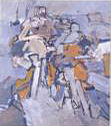Charles Cajori
by Robert Sievert

1. Charles Cajori: [Untitled] (1962)

2. Charles Cajori: Exchange (1994)

3. Charles Cajori: Epistrophy (1998)
The galleries and museums were filled with magnificently flamboyant paintings. There was some underlying secret to all this work and we uninitiated could just look and marvel. It was in the classes of Charles Cajori and Nicolas Carone that we began to understand the structuring and theory that fueled this painting renaissance. It all had to do with plastic space and the play between reality and abstraction.
When I look at the work of Cajori I see a strong affirmation of all the ideas he presented to his classes . Cajori has maintained artistic excellence and continued style over his long career and has produced a large body of work.
A recent show at David Findlay Jr. is a survey of fifty years of his work. One gets a chance to observe the formation of a style both forward looking and referential to the past. In his early watercolors he is clearly looking at the spatial advances begun by Cezanne in the nineteenth century, highly abstracted yet grounded in tabletop still life. The overall image is flattened out and yet it conveys a sense of movement as his forms retreat into the nether regions of the picture plane.
He paints a slippery space. Things seem to slide through the pictures as he establishes positions for his forms. Positioning is one of his main activities.. There is an ambiguity between abstraction and observed form. His dominant theme is the figure and it's surrounding environment.
Over the years he has been committed to drawing and painting the human figure. A 1962 untitled painting presents an image that lays in-between a spatial diagram and a figurative representation. One must enter this picture with a spirit of openness and assemble the figurative situation using both logic and imagination. It truly engages the viewer in the battle between figuration and abstraction and at the same time presents a powerful pictorial statement.
Over the years he becomes more focused on the human aspect of his figures. In later paintings the figures are given faces. I must admit that to me this is a welcome addition. It increases the tension between the persona of his figures and specific spatial design of his pictures.
The direct painting technique he uses does not allow for any modeling or form description. rather it is flat and planar, building depth with overlapping planes and at times pure visceral color impact employing that push and pull Hofmann championed.
One must acknowledge the towering accomplishment of his work. Consistent and ever inventive and yet true to a tradition of modernism established in the twentieth century.
Text copyright © 2005 Robert Sievert
 back to Contents page
back to Contents page